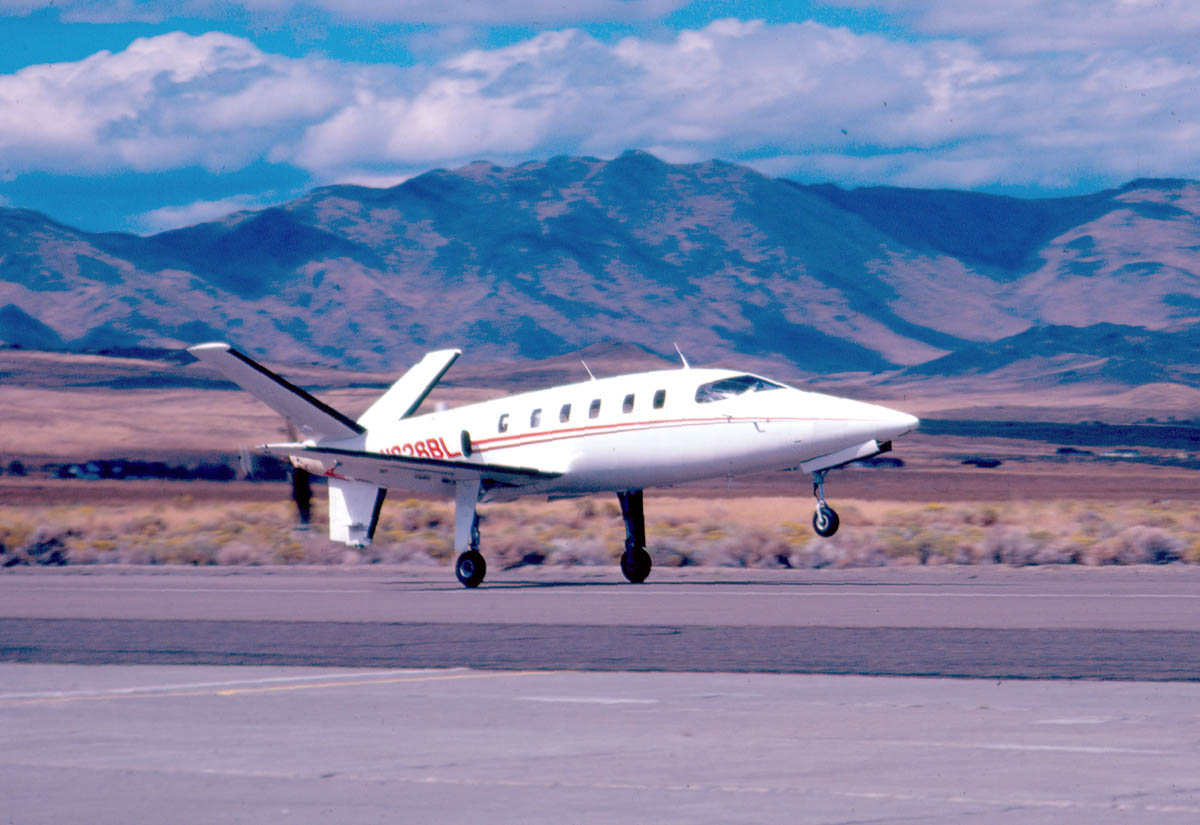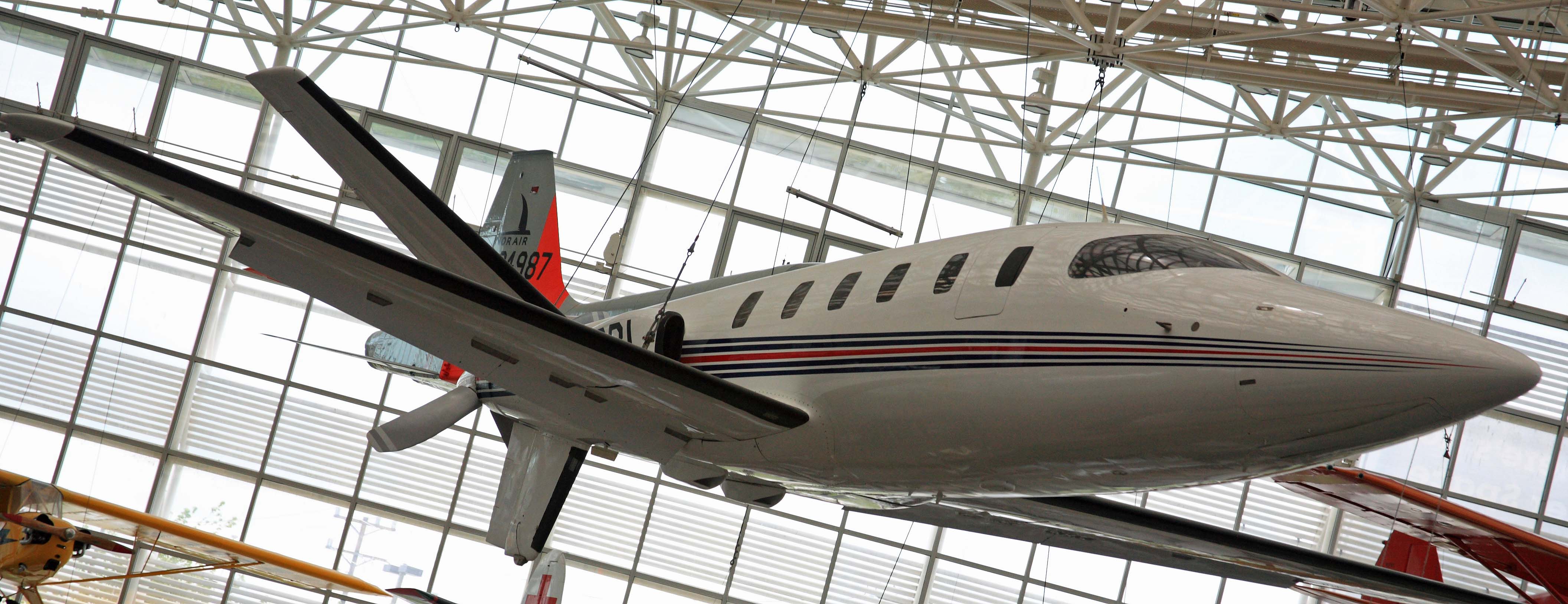LearAvia Lear Fan on:
[Wikipedia]
[Google]
[Amazon]
The LearAvia Lear Fan 2100 was a
 The LearFan was designed by
The LearFan was designed by
. ''The Museum of Flight''. 2009. Retrieved 27 November 2009. The Lear Fan, however, did not enter production. Structural problems were discovered during the pressurization of the all-composite fuselage. The US
. ''
 All three Lear Fan aircraft have been preserved. They are on display at the
All three Lear Fan aircraft have been preserved. They are on display at the Lear Fan in front of CAMI
''Google Maps satellite view''.
. ''Flight International'', 8 June 1985. Sutton, UK:Business Press International. p. 30. * McClellan, J. Mac.
. ''Flying'', June 2006. Retrieved 21 November 2009. * Taylor, John W.R. ''Jane's All The World's Aircraft 1982–83''. London:Jane's Yearbooks, 1982. . * Whitaker, Richard.
. ''Flight International'', 26 December 1981, pp. 1896–1901.
he William P. and Moya Olsen Lear Papers
at The Museum of Flight (Seattle, Wash.) {{Learjet aircraft Abandoned civil aircraft projects of the United States LearFan Twin-engined single-prop pusher aircraft 1980s United States business aircraft V-tail aircraft Low-wing aircraft Twin-engined turboprop aircraft Aircraft first flown in 1981
turboprop
A turboprop is a turbine engine that drives an aircraft propeller.
A turboprop consists of an intake, reduction gearbox, compressor, combustor, turbine, and a propelling nozzle. Air enters the intake and is compressed by the compressor. Fuel ...
business aircraft designed in the 1970s, with an unusual configuration. The Lear Fan never entered production.
Design and development
 The LearFan was designed by
The LearFan was designed by Bill Lear
William Powell Lear (June 26, 1902 – May 14, 1978) was an American inventor and businessman. He is best known for founding Learjet, a manufacturer of business jets. He also invented the battery eliminator for the B battery, and developed the ...
, but not completed before his death in 1978. It was planned for production to be carried out in Belfast
Belfast ( , ; from ga, Béal Feirste , meaning 'mouth of the sand-bank ford') is the capital and largest city of Northern Ireland, standing on the banks of the River Lagan on the east coast. It is the 12th-largest city in the United Kingdo ...
, Northern Ireland
Northern Ireland ( ga, Tuaisceart Éireann ; sco, label= Ulster-Scots, Norlin Airlann) is a part of the United Kingdom, situated in the north-east of the island of Ireland, that is variously described as a country, province or region. Nort ...
, in a new factory built with money from the British Government in an effort to boost employment.McCellan 2006. The aircraft had a pressurized cabin and was designed for a service ceiling of 41,000 ft (12 500 m). It could accommodate two pilots and seven passengers, or one pilot and eight passengers.
It featured a pusher configuration
In an aircraft with a pusher configuration (as opposed to a tractor configuration), the propeller(s) are mounted behind their respective engine(s). Since a pusher propeller is mounted behind the engine, the drive shaft is in compression in nor ...
in which two engines powered a single constant-speed three- or four-bladed propeller
A propeller (colloquially often called a screw if on a ship or an airscrew if on an aircraft) is a device with a rotating hub and radiating blades that are set at a pitch to form a helical spiral which, when rotated, exerts linear thrust upon ...
at the rear of the aircraft. A purpose-built gearbox allowed two Pratt & Whitney Canada PT6
The Pratt & Whitney Canada PT6 is a turboprop aircraft engine produced by Pratt & Whitney Canada.
Its design was started in 1958, it first ran in February 1960, first flew on 30 May 1961, entered service in 1964 and has been continuously upda ...
B turboshaft engines to supply power via two independent driveshafts. The intent of the design was to provide the safety of multi-engine reliability, combined with single-engine handling in case of failure of one of the engines.
The aircraft was made of lightweight composite material
A composite material (also called a composition material or shortened to composite, which is the common name) is a material which is produced from two or more constituent materials. These constituent materials have notably dissimilar chemical or ...
s instead of the more common aluminum
Aluminium (aluminum in American and Canadian English) is a chemical element with the symbol Al and atomic number 13. Aluminium has a density lower than those of other common metals, at approximately one third that of steel. It has ...
alloy.
Another distinctive feature was the Y-shaped empennage
The empennage ( or ), also known as the tail or tail assembly, is a structure at the rear of an aircraft that provides stability during flight, in a way similar to the feathers on an arrow.Crane, Dale: ''Dictionary of Aeronautical Terms, third ed ...
. Two stabilizers pointed upward at an angle, similar to those on a V-tail aircraft
The V-tail or ''Vee-tail'' (sometimes called a butterfly tail or Rudlicki's V-tailGudmundsson S. (2013). "General Aviation Aircraft Design: Applied Methods and Procedures" (Reprint). Butterworth-Heinemann. p. 489. , 9780123973290) of an aircraft ...
, and a short vertical stabilizer pointed downward. However, unlike conventional V-tails, there was no pitch/yaw control mixing on the Lear Fan. The downward-pointing rudder also served to protect the propeller from ground strikes during takeoff and landing.
Operational history
After the cancellation of a planned test flight on December 31, 1980 due to technical issues, the first prototype made its maiden flight on January 1, 1981, a date officially recorded by sympathetic British government officials as "December 32, 1980" in order to secure funding that expired at the end of 1980.Lear Fan 2100 (Futura). ''The Museum of Flight''. 2009. Retrieved 27 November 2009. The Lear Fan, however, did not enter production. Structural problems were discovered during the pressurization of the all-composite fuselage. The US
Federal Aviation Administration
The Federal Aviation Administration (FAA) is the largest transportation agency of the U.S. government and regulates all aspects of civil aviation in the country as well as over surrounding international waters. Its powers include air traffic m ...
refused to issue the prototype with an airworthiness certificate
A standard certificate of airworthiness is a permit for commercial passenger or cargo operation, issued for an aircraft by the civil aviation authority in the state/nation in which the aircraft is registered. For other aircraft such as crop-spraye ...
because of concerns that, despite having two engines, the combining-gearbox that drove the single propeller was not adequately reliable. Development was abandoned in 1985Lear Fan Collapses. ''
Flight International
''Flight International'' is a monthly magazine focused on aerospace. Published in the United Kingdom and founded in 1909 as "A Journal devoted to the Interests, Practice, and Progress of Aerial Locomotion and Transport", it is the world's oldes ...
'' 8 June 1985, p.30. after only three aircraft were built.
Surviving aircraft
 All three Lear Fan aircraft have been preserved. They are on display at the
All three Lear Fan aircraft have been preserved. They are on display at the Museum of Flight
The Museum of Flight is a private non-profit air and space museum in the Seattle metropolitan area. It is located at the southern end of King County International Airport (Boeing Field) in the city of Tukwila, immediately south of Seattle.< ...
in Seattle, Washington
Seattle ( ) is a port, seaport city on the West Coast of the United States. It is the county seat, seat of King County, Washington, King County, Washington (state), Washington. With a 2020 population of 737,015, it is the largest city in bo ...
, the Frontiers of Flight Museum
Frontiers may refer to:
* Frontier, areas near or beyond a boundary
Arts and entertainment Music
* ''Frontiers'' (Journey album), 1983
* ''Frontiers'' (Jermaine Jackson album), 1978
* ''Frontiers'' (Jesse Cook album), 2007
* ''Frontiers'' ( ...
in Dallas, Texas
Dallas () is the third largest city in Texas and the largest city in the Dallas–Fort Worth metroplex, the fourth-largest metropolitan area in the United States at 7.5 million people. It is the largest city in and seat of Dallas County w ...
, and on static display in front of the Civil Aerospace Medical Institute
Civil Aerospace Medical Institute (CAMI) is the medical certification, education, research, and occupational medicine wing of the Office of Aerospace Medicine (AAM) under the auspices of the Federal Aviation Administration Office of Aviation Safet ...
in Oklahoma City, Oklahoma
Oklahoma City (), officially the City of Oklahoma City, and often shortened to OKC, is the capital and largest city of the U.S. state of Oklahoma. The county seat of Oklahoma County, it ranks 20th among United States cities in population, and ...
.''Google Maps satellite view''.
Specifications
See also
References
Citations
Bibliography
*. ''Flight International'', 8 June 1985. Sutton, UK:Business Press International. p. 30. * McClellan, J. Mac.
. ''Flying'', June 2006. Retrieved 21 November 2009. * Taylor, John W.R. ''Jane's All The World's Aircraft 1982–83''. London:Jane's Yearbooks, 1982. . * Whitaker, Richard.
. ''Flight International'', 26 December 1981, pp. 1896–1901.
External links
* *he William P. and Moya Olsen Lear Papers
at The Museum of Flight (Seattle, Wash.) {{Learjet aircraft Abandoned civil aircraft projects of the United States LearFan Twin-engined single-prop pusher aircraft 1980s United States business aircraft V-tail aircraft Low-wing aircraft Twin-engined turboprop aircraft Aircraft first flown in 1981